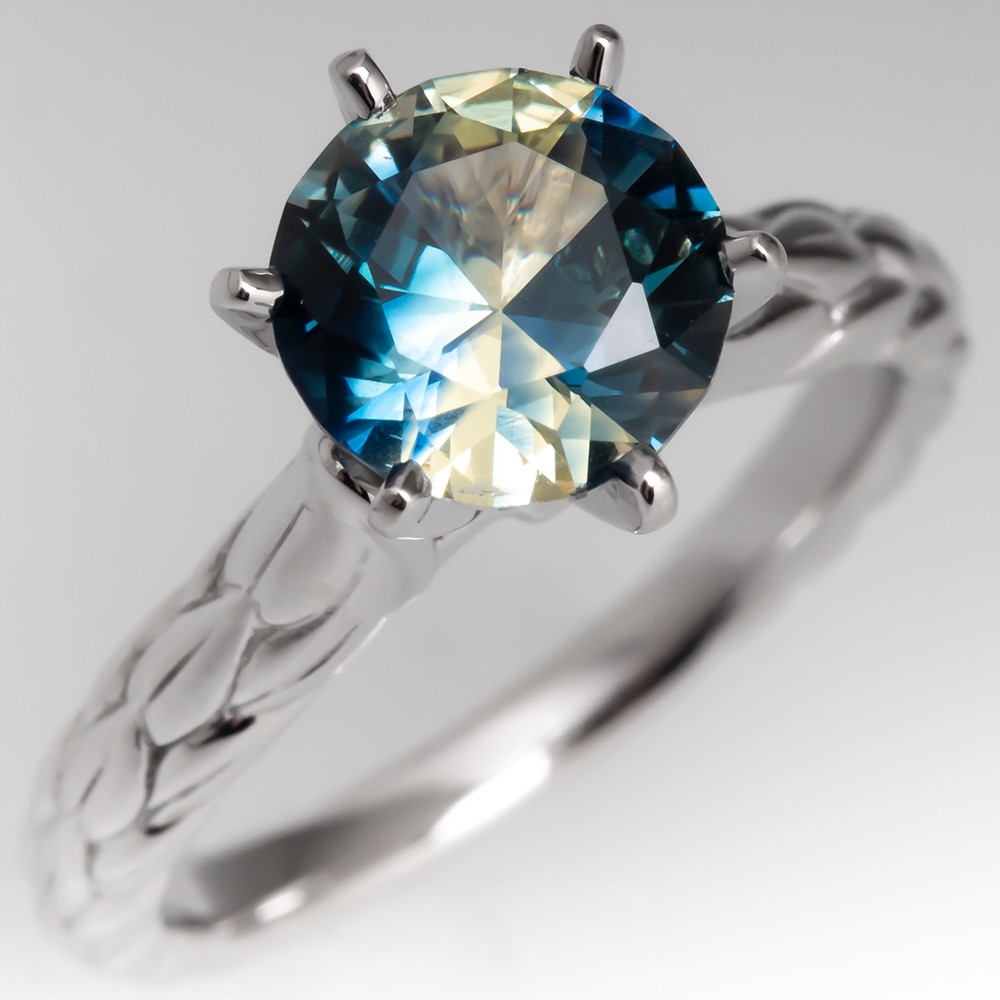Posted in: All Things Jewelry
 A gorgeous Parti Sapphire engagement ring that creates a butterfly pattern. Photo ©2018 EraGem Jewelry.
Parti sapphires comprise a gorgeous and rare class of corundum. All sapphires belong to the corundum family, a class of gemstones comprised primarily of aluminum and oxygen (aluminum oxide). Parti sapphires include traces of iron and titanium to produce exquisite zones of colors in the same stone.
A gorgeous Parti Sapphire engagement ring that creates a butterfly pattern. Photo ©2018 EraGem Jewelry.
Parti sapphires comprise a gorgeous and rare class of corundum. All sapphires belong to the corundum family, a class of gemstones comprised primarily of aluminum and oxygen (aluminum oxide). Parti sapphires include traces of iron and titanium to produce exquisite zones of colors in the same stone.
Sapphire Characteristics
In its purest state corundum appears clear white, like a diamond. In fact, at one time pure corundum posed as diamonds in jewelry. However, the rarity of the pure white stone forced jewelers to seek other options for diamond alternatives. Corundum is a hard gemstone, rating a 9 on the Mohs Scale of Hardness. All sapphires, whether blue, green, yellow, red, or pink, belong to the corundum family. Consequently, all sapphires lend themselves to daily wear. Their hardness protects them from harm throughout most of an ordinary day. Sapphires can be worn every day, as long as they are removed before engaging in heavy work, like gardening, welding, or construction. Another bonus of sapphires is that they come in almost every color of the rainbow. Although blue and red/pink (ruby) sapphires are the most popular engagement ring stones, colored gemstone engagement rings are growing in popularity. Depending on your preference, you could choose a green, yellow, or even a violet sapphire. You could also choose among two types of very special sapphires - the color change sapphires and the parti sapphires. Color change sapphires will appear one color in dim lighting and another color entirely in bright light.Parti Sapphires
Unlike color change sapphires, parti sapphires do not change color in different light. They actually display different colors in different regions of the stone, under all light. Deep in the earth, as the corundum forms, different trace minerals infiltrate the crystal structure in distinct zones. These trace minerals create areas of differing colors, most particularly regions of green, blue, and/or yellow. Most parti sapphires display two colors. However, some of these special sapphires display three different color zones. These exceptional sapphires primarily come from Australia, though they have also been found in Nigeria, Madagascar, and Tanzania. The rarity of parti sapphires endows them with exceptional value. Typically, the brighter the color zones, the higher the price per carat. Usually, parti sapphires radiate in yellows and blues. The most unusual parti sapphire is called Pharaoh's Eye, a blue crystal with a yellow core. In light of their unusual color zones, gem cutters typically cut parti sapphires to enhance the color, rather than to preserve carat weight. This can result in unusual cuts with some deviations from the uniform cuts associated with more typical sapphires. Rarely will parti stones be free of inclusions, therefore clarity does not play as large a role in determining value as it does for, say, a diamond.What's In the Color?
As mentioned above, parti sapphires, like all sapphires, obtain their colors from the intrusion of trace minerals. Zones colored yellow or yellow-brown contain trace amounts of only iron. Those with blue zones contain titanium with very scant traces of iron. On the other hand, those with titanium and higher traces of iron appear green. The parti sapphire engagement ring pictured above contains zones of deep blue (with a hint of green) and an almost brownish-yellow. The gemstone cutter capitalized on the placement of these color zones to create an enchanting butterfly effect when the light catches the facets. This beautiful ring can be yours. Simply give us a call and make an appointment to visit our Bellevue showroom.6 years ago
2 view(s) 